| Article ID | Journal | Published Year | Pages | File Type |
|---|---|---|---|---|
| 3951974 | International Journal of Gynecology & Obstetrics | 2008 | 6 Pages |
ObjectiveTo determine whether assessing uterine perfusion and angiogenic factors concurrently in the second trimester improves the prediction of pre-eclampsia and intrauterine growth restriction (IUGR).MethodPlasma levels of soluble fms-like tyrosine kinase 1 (sFlt-1) and placental growth factor (PlGF) were measured for 108 women with abnormal uterine perfusion on Doppler velocimetry in the 23rd week. Later, 33 cases of pre-eclampsia and 9 of IUGR developed.ResultsCompared with the plasma levels of the women whose pregnancies remained normal, sFlt-1 levels were significantly higher and PlGF levels significantly lower in the women whose pregnancies became complicated by pre-eclampsia and/or IUGR (P < 0.001). The alterations were more pronounced in cases of early-onset pre-eclampsia and in cases of IUGR that necessitated delivery before 34 weeks. Using the sFlt-1/PlGF ratio, these complications could be predicted with 98% sensitivity, 95% specificity, and 93% positive predictive value.ConclusionMeasuring uterine perfusion and angiogenic factors concurrently in the second trimester improved the prediction of pre-eclampsia and IUGR.
